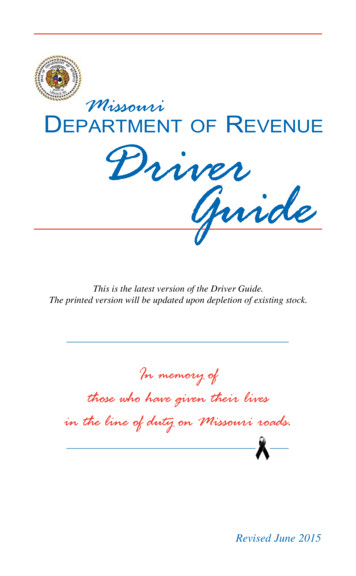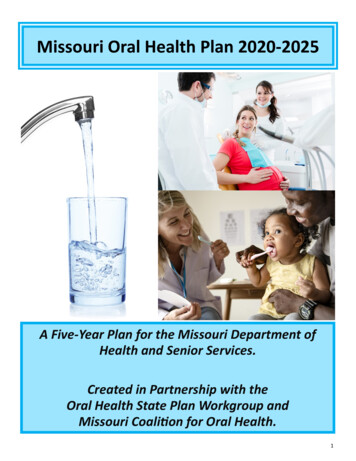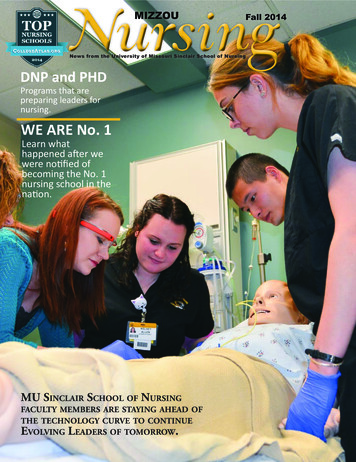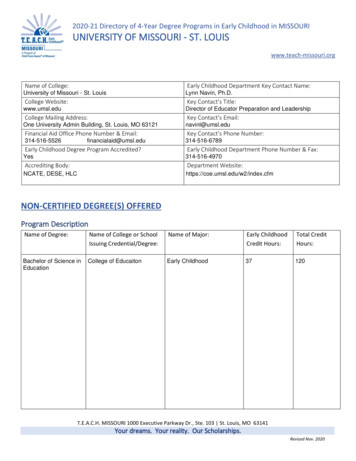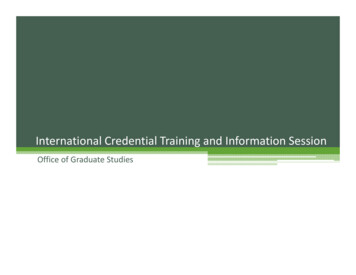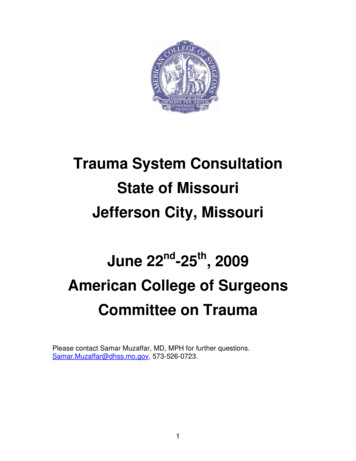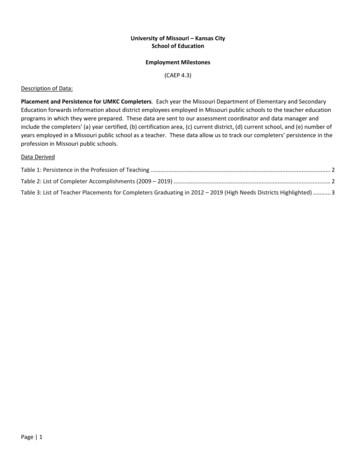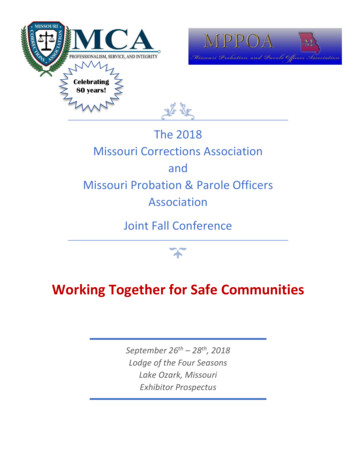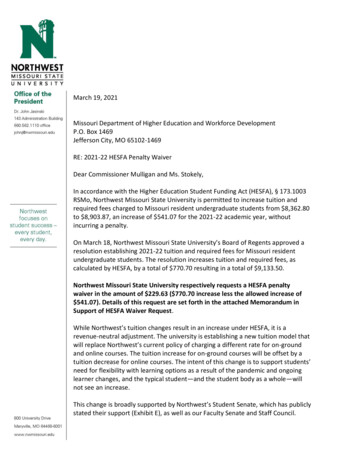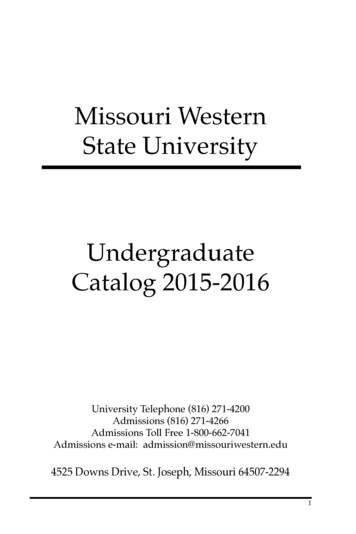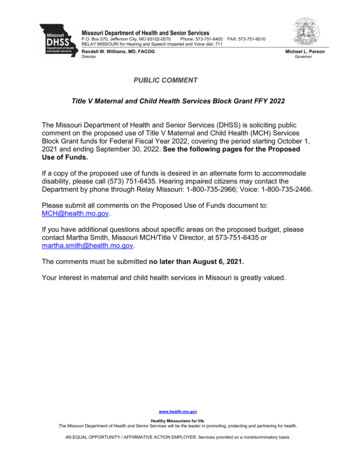
Transcription
Missouri Department of Health and Senior ServicesP.O. Box 570, Jefferson City, MO 65102-0570Phone: 573-751-6400RELAY MISSOURI for Hearing and Speech Impaired and Voice dial: 711FAX: 573-751-6010Randall W. Williams, MD, FACOGMichael L. ParsonDirectorGovernorPUBLIC COMMENTTitle V Maternal and Child Health Services Block Grant FFY 2022The Missouri Department of Health and Senior Services (DHSS) is soliciting publiccomment on the proposed use of Title V Maternal and Child Health (MCH) ServicesBlock Grant funds for Federal Fiscal Year 2022, covering the period starting October 1,2021 and ending September 30, 2022. See the following pages for the ProposedUse of Funds.If a copy of the proposed use of funds is desired in an alternate form to accommodatedisability, please call (573) 751-6435. Hearing impaired citizens may contact theDepartment by phone through Relay Missouri: 1-800-735-2966; Voice: 1-800-735-2466.Please submit all comments on the Proposed Use of Funds document to:MCH@health.mo.gov.If you have additional questions about specific areas on the proposed budget, pleasecontact Martha Smith, Missouri MCH/Title V Director, at 573-751-6435 ormartha.smith@health.mo.gov.The comments must be submitted no later than August 6, 2021.Your interest in maternal and child health services in Missouri is greatly valued.www.health.mo.govHealthy Missourians for life.The Missouri Department of Health and Senior Services will be the leader in promoting, protecting and partnering for health.AN EQUAL OPPORTUNITY / AFFIRMATIVE ACTION EMPLOYER: Services provided on a nondiscriminatory basis.
TITLE V MATERNAL AND CHILD HEALTH SERVICES BLOCK GRANTFFY 2022 PROPOSED USE OF FUNDS(Released for Public Comment July 2021)DEVELOPMENT OF APPLICATIONThe Title V MCH Services Block Grant is administered by the Health Resources andServices Administration’s (HRSA) Maternal and Child Health Bureau (MCHB). InMissouri, DHSS is the designated state agency for the allocation and administration ofTitle V MCH Block Grant funds, and the Title V Program is located within the Division ofCommunity and Public Health (DCPH). As part of the development of the annualapplication, public comment on the proposed use of funds is solicited from MCHstakeholders, the general public, and other interested parties. The proposed plan for theuse of block grant funds to improve the health status of women and children, includingchildren with special health care needs (CSHCN), for FFY 2022 is attached.TITLE V MCH SERVICES BLOCK GRANT FFY 2021-2025 PRIORITIESHRSA/MCHB requires states to conduct a comprehensive statewide NeedsAssessment every five years that identifies the need for preventive and primary careservices for pregnant women, mothers, infants, children, and CSHCN. Findings from theFive-Year Needs Assessment then serve as the cornerstone for development of a fiveyear Title V MCH State Action Plan (SAP). States are required to select a minimum offive National Performance Measures (NPMs), with at least one NPM in each of the fivepopulation domains, and states may select as many NPMs and State PerformanceMeasures (SPMs) as necessary to address each priority need. Eight FFY2021-2025priorities were identified from the results of the statewide 2020 MCH NeedsAssessment, with 5 NPMs, 3 SPMs, and 2 overarching principles. Beyond the selectedpriorities, there is flexibility to address additional MCH priorities and ongoing andemerging issues and implement initiatives not specified in the SAP.National Priority Areas:1. Improve pre-conception, prenatal and postpartum health care services forwomen of child bearing age – Well Woman Care (Women/Maternal Health)2. Promote safe sleep practices among newborns to reduce sleep-related infantdeaths - Safe Sleep (Perinatal/Infant Health)3. Reduce intentional and unintentional injuries among children and adolescents –Injury Hospitalization (Adolescent Health)4. Reduce obesity among children and adolescents - Physical Activity (ChildHealth)5. Ensure coordinated, comprehensive and ongoing health care services forchildren with and without special health care needs – Medical Home (CSHCN)State Priority Areas:1. Enhance access to oral health care services for children – Preventive Dental Visit(Child Health)2. Promote Protective Factors for Youth and Families – Youth Suicide & Self-Harm(Adolescent Health)
3. Address Social Determinants of Health Inequities – Training & Health Literacy(Cross-cutting)Overarching Principles: Ensure Access to Care, including adequate insurance coverage, for MCHpopulation Promote partnerships with individuals, families, and family-led organizations toensure family engagement in decision-making, program planning, servicedelivery, and quality improvement activitiesOVERVIEW OF PROPOSED FFY 2022 TITLE V BUDGETThe FFY 2022 budget projections are based on the final award amount for the Title VMCH Block Grant in Federal Fiscal Year 2020, and every effort will be made to maintainTitle V support for essential MCH programs, services, and partnerships with theproposed use of funds. This year, programs requested 13,088,625, which is 846,173above the amount of FFY 2020 funding received. This increase is largely due to theapproved 2% increase in state employee salaries, effective January 1, 2021, and anadditional 0.8 FTE requested than the previous year. The ongoing goal is to ensuremaintaining or increasing services for the MCH population in Missouri, and anyadditional budget needs not covered by the FFY 2022 Title V MCH Block Grant awardwill be funded with lapses in FFY 2021 funding. Lapses in FFY 2021 funding areprimarily due to ongoing vacancies and restrictions resulting from the COVID-19pandemic. If the FFY 2022 funding received and/or FFY 2021 lapsed funding is lessthan anticipated and/or needed, the Title V MCH Program will prioritize FFY 2022activities and initiatives, while maintaining the core services provided for the MCHpopulation in prior years. Similarly, any additional funding received beyond theanticipated award will be appropriately allocated to programs and initiatives serving theMCH population.
FFY 2022 TITLE V MATERNAL AND CHILD HEALTH SERVICESPROPOSED USE OF FUNDSFUNDINGTOTAL FUNDS APPLIED FORPROPOSEDFFY 2022 FUNDING BY SERVICE LEVELSDirect Care ServicesAssistive TechnologyOral Health ServicesChildhood Lead Poisoning PreventionTotal Direct Care ServiceEnabling ServicesChild Care InitiativesLPHA MCH Services ContractsCSHCN Service CoordinationFamily PartnershipHealthy FamiliesLead Hazard Reduction/AbatementOral Health ServicesTotal Enabling ServicesPublic Health Service andSystemsAdolescent HealthCCHC ContractsCoordination and Systems DevelopmentEpidemiological ServicesGenetic ServicesHealthy FamiliesInjury PreventionLPHA MCH Services ContractsNutrition ProjectsObesity PreventionOral Health ServicesOutreach and Education (TEL-LINK)School HealthWomen's Health InitiativesTotal Public Health Service andSystemsAdministration (Up to 10% allowed)Grand Total13,088,625PROPOSEDFFY 2022 100,000177,8145,084 3 ,635,55324,00052,43052,00013,92517,000130,540 1,086,820SUBTOTAL 282,899 4,298,396 7,420,511 1,086,820 13,088,625
Missouri Core Public Health Services for MCH Populations by Levels of ServiceFFY 2022 Title V MCH Services Block GrantTo develop the FFY 2022 Title V MCH Services Block Grant application, Missouri followedinstruction from the HRSA/Maternal and Child Health Bureau guidance document for statesentitled, Title V Maternal and Child Health Services Block Grant to States Program: Guidance andForms for the Title V Application/Annual Report, OMB No. 0915-0172, which expires on January31, 2024. The levels of services included in this guidance to address the needs of the MCHpopulation in Missouri are Direct Services, Enabling Services, and Public Health Services andSystems. The description of each of the levels are as follows:Direct Services:Direct services are preventive, primary, or specialty clinical services to pregnant women, infantsand children, including children with special health care needs, where MCH Services Block Grantfunds are used to reimburse or fund providers for these services through a formal process similarto paying a medical billing claim or managed care contracts. State reporting on direct servicesshould not include the costs of clinical services which are delivered with Title V dollars butreimbursed by Medicaid, CHIP or other public or private payers. Examples include, but are notlimited to, preventive, primary or specialty care visits, emergency department visits, inpatientservices, outpatient and inpatient mental and behavioral health services, prescription drugs,occupational and physical therapy, speech therapy, durable medical equipment and medicalsupplies, medical foods, dental care, and vision care.Enabling Services:Enabling services are non-clinical services (i.e., not included as direct or public health services)that enable individuals to access health care and improve health outcomes where MCH ServicesBlock Grant funds are used to finance these services. Enabling services include, but are not limitedto: case management, care coordination, referrals, translation/interpretation, transportation,eligibility assistance, health education for individuals or families, environmental health riskreduction, health literacy, and outreach. State reporting on enabling services should not include thecosts for enabling services that are reimbursed by Medicaid, CHIP, or other public and privatepayers. This category may include salary and operational support to a clinic that enable individualsto access health care or improve health outcomes. Examples include the salary of a public healthnurse who provides prenatal care in a local clinic or compensation provided to a specialistpediatrician who provides services for children with special health care needs. In both cases thedirect services might still be billed to Medicaid or other insurance, but providing for the availabilityof the provider enables individuals to access the services.Public Health Services and Systems:Public health services and systems are activities and infrastructure to carry out the core publichealth functions of assessment, assurance, and policy development, and the 10 essential publichealth services. Examples include the development of standards and guidelines, needsassessment, program planning, implementation, and evaluation, policy development, qualityassurance and improvement, workforce development, and population-based disease preventionand health promotion campaigns for services such as newborn screening, immunization, injuryprevention, safe-sleep education and anti-smoking. State reporting on public health services andsystems should not include costs for direct clinical preventive services, such as immunization,newborn screening tests, or smoking cessation. Also included are MCH Epidemiological Servicesand program evaluation, MCH workforce capacity and technical assistance for programcoordination and systems development, and LPHA community-based system-building through theMCH Services contract.
MCH Block Grant in Federal Fiscal Year 2020, and every effort will be made to maintain Title V support for essential MCH programs, services, and partnerships with the proposed use of funds. This year, programs requested 13,088,625, which is 846,173 above the amount of FFY 2020 funding received. This increase is largely due to the
